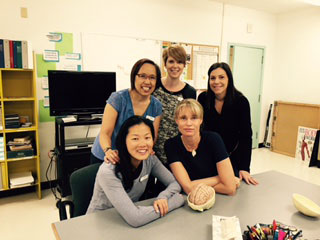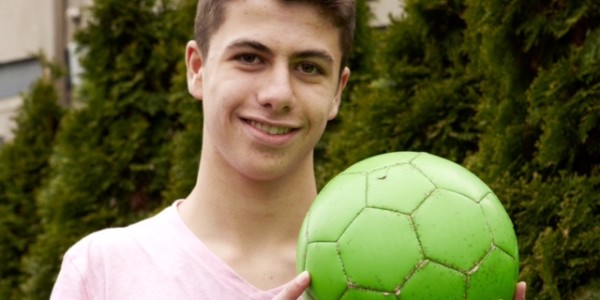GF Strong team takes concussions head on
“As a therapist and a parent of two soccer players, I’ve seen too many kids with soccer concussions and they haven’t been well managed,” says Kathy Wong, an occupational therapist with the GF Strong (GFS) Rehabilitation Centre’s Adolescent and Young Adult (AYA) Program.
Felix Todd, a grade 10 student and former client of the AYA’s Adolescent Complex Concussion Clinic, sustained a concussion when his head hit an opposing player’s head instead of the soccer ball. “I felt drowsy, but I wasn’t sure if this was a concussion.” It was his fourth.
Children and youth have a greater risk of concussions than the general population, with sports, transport-related events and falls accounting for a majority of concussion hospitalization in the 0-19 age group across VCH.
“We know from studies that concussion is common in kids, and a lot of those are linked to sport and play,” says Dr. John Carsley, medical health officer.
Educating the educators

Members of GF Strong’s Adolescent and Young Adult Program are some of the brains behind the new Concussion Toolkit for School Professionals.
The AYA team, in partnership with the ministries of Health and Education, has produced a comprehensive resource specifically for school professionals. “This is part of the overall emphasis that VCH is putting on brain injury,” explains John.
Nearly two years of development have gone into the online module for educators, the third in the Concussion Awareness Training Tool (CATT) managed by the BC Injury Research & Prevention Unit. The Concussion Toolkit for School Professionals joins a module for medical professionals, and another for parents, players and coaches.
“We assisted with creating a module that could help educate school professionals on the effects that concussion has on learning, provide them with information on how to support students during the recovery process, and to support a child’s re-entry back to school after a concussion injury – it’s the return-to-learn piece,” says Helen Salatellis, a Vancouver School Board teacher and AYA team member.
For Felix, although returning to school was challenging, he had the help of another AYA teacher, Robyn Littleford, and her gradual return-to-school plan. Today, Felix is attending most of his classes, with the exception of music and PE. “I didn’t realize it would be so hard to be organized and to concentrate in class, but I feel very supported at school.”
Prevention through education
“A lot of kids are seen by general practitioners and walk-in clinics and these cases aren’t captured in VCH or other health authority concussion data. It’s really hard to get a definitive statistic,” says Kathy.
But, we can get a good read on prevention, and that begins with education.
“Education and awareness are important for reducing concussion in kids,” says Kathy, and that’s where the CATT program comes in. It’s accessible to anyone online, and the modules are updated every two weeks so that content remains current in the rapidly changing world of concussions.
“It’s also important that children and youth receive standardized concussion care,” adds Kathy. “The Canadian Guidelines for Pediatric Concussion can be used by health care professionals, parents, school boards and community sports organizations.”
To raise awareness and maximize use of the Concussion Toolkit for School Professionals, the AYA team is working on increasing dissemination of the educator module in rural B.C. In the Fall, medical health officers aim to bring the new module to the attention of their school districts “to figure out the best way to get educators up to speed,” says John.
Learn more
Concussion Toolkit for School Professionals
Concussion Among Children & Youth: Vancouver Coastal Health Authority
Canadian Guidelines for Pediatric Concussion

